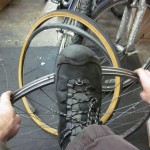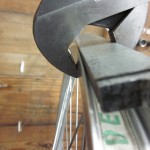Bent Rims
Although some rims may be too far gone to true, many can actually be bent back into shape pretty successfully. So what’s worse: a rim which has been trued, appears true but has wildly uneven spoke tension or one which has been hammered back thus attaining much more even tension.
Rims don’t generally crack unless they have sustained significant damage. This may occur at the seam or when the sidewall is very worn. An unevenly tensioned wheel- or one which has spokes so tight you can barely turn them without stripping the nipples- is not going to withstand the rigors of use.
 By selecting the bent rim section and bending/ whacking it back into true-ness you can often add a bit more life to a wheel, sometimes getting it just about as new. Although whacking a wheel on the ground, stepping on it or pushing on it with your foot might get you home on an otherwise unrideable rim, hitting it methodically with a rubber mallet can sometimes do wonders. Mark the bent section in the truing stand with your fingers by grabbing the two spokes closest to the arc of the bend. Many bends are sharper toward one side (“s” bends for one) so be prepared to hit the bend at its most severe spot- which could be off of center. Start gently and return to the stand to check your progress. Better to under power than over do it. You shouldn’t actually have to loosen the spokes up as the tight ones will be those your hammering toward. Wider bends may need less force than those only three spokes wide.
By selecting the bent rim section and bending/ whacking it back into true-ness you can often add a bit more life to a wheel, sometimes getting it just about as new. Although whacking a wheel on the ground, stepping on it or pushing on it with your foot might get you home on an otherwise unrideable rim, hitting it methodically with a rubber mallet can sometimes do wonders. Mark the bent section in the truing stand with your fingers by grabbing the two spokes closest to the arc of the bend. Many bends are sharper toward one side (“s” bends for one) so be prepared to hit the bend at its most severe spot- which could be off of center. Start gently and return to the stand to check your progress. Better to under power than over do it. You shouldn’t actually have to loosen the spokes up as the tight ones will be those your hammering toward. Wider bends may need less force than those only three spokes wide.
 Although there are other methods for reshaping rims which can achieve similar results, I’ve had the best luck with blocks and rubber mallet- especially with aluminum. Some rims (steel esp) may require other less precise methods to get out larger bends. Obviously high quality rims, those with bad seams, flat spots, or those destined for heavy riders are not likely candidates. Rear wheels especially may just need to be replaced.
Although there are other methods for reshaping rims which can achieve similar results, I’ve had the best luck with blocks and rubber mallet- especially with aluminum. Some rims (steel esp) may require other less precise methods to get out larger bends. Obviously high quality rims, those with bad seams, flat spots, or those destined for heavy riders are not likely candidates. Rear wheels especially may just need to be replaced.
 For flat spots there are a few tools out there designed to pull out dents- most of which tend to leave the rim in almost as bad a shape, often creating additional dents from the tool itself. By using a semi circular cut-out piece of narrow plywood or clamping two pieces in a “v” shape in a vise( thin enough to just fit inside the sidewalls), one has a chance of undoing what the road has done. Loosen a few spokes around the bend and remove at least one from the rim. Hammer downward gently at first checking progress using the spoke you removed as a ruler to gauge progress. The ri
For flat spots there are a few tools out there designed to pull out dents- most of which tend to leave the rim in almost as bad a shape, often creating additional dents from the tool itself. By using a semi circular cut-out piece of narrow plywood or clamping two pieces in a “v” shape in a vise( thin enough to just fit inside the sidewalls), one has a chance of undoing what the road has done. Loosen a few spokes around the bend and remove at least one from the rim. Hammer downward gently at first checking progress using the spoke you removed as a ruler to gauge progress. The ri m may have a slight outward bend which will be pulled back by the spokes but not much. It is very important not to over do this technique as it is extremely difficult to undo. Sometimes a “hop” can actually be caused by tight spokes from truing a damaged rim. The out of roundness being a byproduct of getting the bent rim true from side to side.
m may have a slight outward bend which will be pulled back by the spokes but not much. It is very important not to over do this technique as it is extremely difficult to undo. Sometimes a “hop” can actually be caused by tight spokes from truing a damaged rim. The out of roundness being a byproduct of getting the bent rim true from side to side.
Pulling out simple sidewall dings can be as easy as putting an adjustable wrench over the ding and bending.
 Place the wrench as closely around the actual bend, use a thin piece of plastic over the leverage point or place this point down by the edge of the rim sidewall to reduce further damage. Most dings can be removed pretty effectively this way or by grabbing the rim edge directly for very small bends or using an aditional leveraging device for larger/ wider ones. Emery cloth or plastic headed hammer might help to approximate a smooth braking surface if needed.
Place the wrench as closely around the actual bend, use a thin piece of plastic over the leverage point or place this point down by the edge of the rim sidewall to reduce further damage. Most dings can be removed pretty effectively this way or by grabbing the rim edge directly for very small bends or using an aditional leveraging device for larger/ wider ones. Emery cloth or plastic headed hammer might help to approximate a smooth braking surface if needed.

